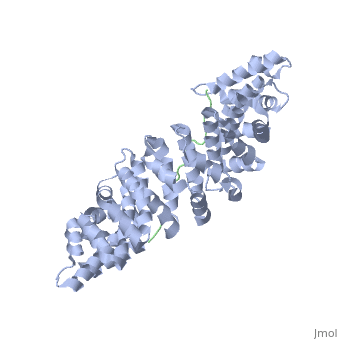1ee5
From Proteopedia
(Difference between revisions)
| Line 1: | Line 1: | ||
| - | + | ==YEAST KARYOPHERIN (IMPORTIN) ALPHA IN A COMPLEX WITH A NUCLEOPLASMIN NLS PEPTIDE== | |
| - | + | <StructureSection load='1ee5' size='340' side='right' caption='[[1ee5]], [[Resolution|resolution]] 2.40Å' scene=''> | |
| - | + | == Structural highlights == | |
| + | <table><tr><td colspan='2'>[[1ee5]] is a 2 chain structure with sequence from [http://en.wikipedia.org/wiki/Saccharomyces_cerevisiae Saccharomyces cerevisiae] and [http://en.wikipedia.org/wiki/Xenopus_laevis Xenopus laevis]. The January 2007 RCSB PDB [http://pdb.rcsb.org/pdb/static.do?p=education_discussion/molecule_of_the_month/index.html Molecule of the Month] feature on ''Importins'' by David S. Goodsell is [http://dx.doi.org/10.2210/rcsb_pdb/mom_2007_1 10.2210/rcsb_pdb/mom_2007_1]. Full crystallographic information is available from [http://oca.weizmann.ac.il/oca-bin/ocashort?id=1EE5 OCA]. For a <b>guided tour on the structure components</b> use [http://oca.weizmann.ac.il/oca-docs/fgij/fg.htm?mol=1EE5 FirstGlance]. <br> | ||
| + | </td></tr><tr><td class="sblockLbl"><b>[[Related_structure|Related:]]</b></td><td class="sblockDat">[[1bk6|1bk6]], [[1ee4|1ee4]]</td></tr> | ||
| + | <tr><td class="sblockLbl"><b>Resources:</b></td><td class="sblockDat"><span class='plainlinks'>[http://oca.weizmann.ac.il/oca-docs/fgij/fg.htm?mol=1ee5 FirstGlance], [http://oca.weizmann.ac.il/oca-bin/ocaids?id=1ee5 OCA], [http://www.rcsb.org/pdb/explore.do?structureId=1ee5 RCSB], [http://www.ebi.ac.uk/pdbsum/1ee5 PDBsum]</span></td></tr> | ||
| + | <table> | ||
| + | == Evolutionary Conservation == | ||
| + | [[Image:Consurf_key_small.gif|200px|right]] | ||
| + | Check<jmol> | ||
| + | <jmolCheckbox> | ||
| + | <scriptWhenChecked>select protein; define ~consurf_to_do selected; consurf_initial_scene = true; script "/wiki/ConSurf/ee/1ee5_consurf.spt"</scriptWhenChecked> | ||
| + | <scriptWhenUnchecked>script /wiki/extensions/Proteopedia/spt/initialview01.spt</scriptWhenUnchecked> | ||
| + | <text>to colour the structure by Evolutionary Conservation</text> | ||
| + | </jmolCheckbox> | ||
| + | </jmol>, as determined by [http://consurfdb.tau.ac.il/ ConSurfDB]. You may read the [[Conservation%2C_Evolutionary|explanation]] of the method and the full data available from [http://bental.tau.ac.il/new_ConSurfDB/chain_selection.php?pdb_ID=2ata ConSurf]. | ||
| + | <div style="clear:both"></div> | ||
| + | <div style="background-color:#fffaf0;"> | ||
| + | == Publication Abstract from PubMed == | ||
| + | BACKGROUND: Karyopherin alpha (importin alpha) is an adaptor molecule that recognizes proteins containing nuclear localization signals (NLSs). The prototypical NLS that is able to bind to karyopherin alpha is that of the SV40 T antigen, and consists of a short positively charged sequence motif. Distinct classes of NLSs (monopartite and bipartite) have been identified that are only partly conserved with respect to one another but are nevertheless recognized by the same receptor. RESULTS: We report the crystal structures of two peptide complexes of yeast karyopherin alpha (Kapalpha): one with a human c-myc NLS peptide, determined at 2.1 A resolution, and one with a Xenopus nucleoplasmin NLS peptide, determined at 2.4 A resolution. Analysis of these structures reveals the determinants of specificity for the binding of a relatively hydrophobic monopartite NLS and of a bipartite NLS peptide. The peptides bind Kapalpha in its extended surface groove, which presents a modular array of tandem binding pockets for amino acid residues. CONCLUSIONS: Monopartite and bipartite NLSs bind to a different number of amino acid binding pockets and make different interactions within them. The relatively hydrophobic monopartite c-myc NLS binds extensively at a few binding pockets in a similar manner to that of the SV40 T antigen NLS. In contrast, the bipartite nucleoplasmin NLS engages the whole array of pockets with individually more limited but overall more abundant interactions, which include the NLS two basic clusters and the backbone of its non-conserved linker region. Versatility in the specific recognition of NLSs relies on the modular. | ||
| - | + | Crystallographic analysis of the specific yet versatile recognition of distinct nuclear localization signals by karyopherin alpha.,Conti E, Kuriyan J Structure. 2000 Mar 15;8(3):329-38. PMID:10745017<ref>PMID:10745017</ref> | |
| - | + | ||
| + | From MEDLINE®/PubMed®, a database of the U.S. National Library of Medicine.<br> | ||
| + | </div> | ||
==See Also== | ==See Also== | ||
*[[Biological Unit|Biological Unit]] | *[[Biological Unit|Biological Unit]] | ||
| + | *[[Importin|Importin]] | ||
*[[Nucleoplasmin|Nucleoplasmin]] | *[[Nucleoplasmin|Nucleoplasmin]] | ||
| - | + | == References == | |
| - | == | + | <references/> |
| - | < | + | __TOC__ |
| + | </StructureSection> | ||
[[Category: Importins]] | [[Category: Importins]] | ||
[[Category: RCSB PDB Molecule of the Month]] | [[Category: RCSB PDB Molecule of the Month]] | ||
Revision as of 15:36, 29 September 2014
YEAST KARYOPHERIN (IMPORTIN) ALPHA IN A COMPLEX WITH A NUCLEOPLASMIN NLS PEPTIDE
| |||||||||||


